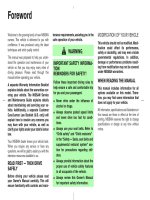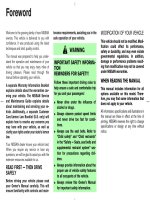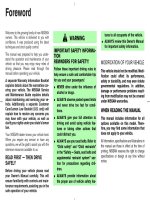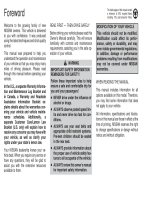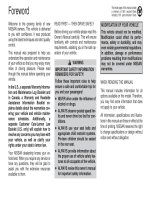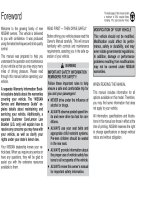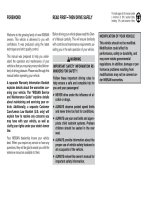NISSAN FRONTIER 2000 OWNER MANUAL SÁCH HƯỚNG dẫn sử DỤNG
Bạn đang xem bản rút gọn của tài liệu. Xem và tải ngay bản đầy đủ của tài liệu tại đây (2.19 MB, 269 trang )
Welcome to the growing family of new NIS-
SAN owners. This vehicle has been deliv-
ered to you with confidence. It was pro-
duced using the latest techniques and strict
quality control.
This manual was prepared to help you
understand the operation and maintenance
of your vehicle so that you may enjoy many
miles of driving pleasure. Please read
through this manual before operating your
vehicle.
In the U.S., a separate Warranty Informa-
tion and Maintenance Log Booklet or in
Canada, a Warranty and Roadside Assis-
tance Information Booklet explains de-
tails about the warranties covering your
vehicle and vehicle maintenance sched-
ules. Additionally, a separate Customer
Care/Lemon Law Booklet (U.S. only) will
explain how to resolve any concerns you
may have with your vehicle, as well as
clarify your rights under your state’s
lemon law.
Your NISSAN dealership knows your ve-
hicle best. When you require any service or
have any questions, they will be glad to
assist you with the extensive resources
available to them.
READ FIRST - THEN DRIVE
SAFELY
Before driving your vehicle please read this
owner’s manual carefully. This will ensure
familiarity with controls and maintenance
requirements, assisting you in the safe op-
eration of your vehicle.
WARNING
IMPORTANT SAFETY INFORMATION
REMINDERS FOR SAFETY!
Follow these important driving rules to
help ensure a safe and complete trip for
you and your passengers
• NEVER drive under the influence of
alcohol or drugs.
• ALWAYS observe posted speed lim-
its and never drive too fast for con-
ditions.
• ALWAYS use your seat belts and
appropriate child restraint systems.
• ALWAYS provide information about
the proper use of vehicle safety fea-
tures to all occupants of the vehicle.
•
ALWAYS review this owner’s manual
for important safety information.
For descriptions specified for four-wheel
drive models, a
mark is placed at
the beginning of the applicable
sections/items.
As with other vehicles with features for
off-road use, failure to operate four-
wheel drive models correctly may result
in loss of control or an accident. Be sure
to read ‘‘Driving safety precautions ’’ in
the ‘‘Starting and driving’’ section of this
manual.
ON-PAVEMENT AND OFF-ROAD DRIV-
ING
This vehicle will handle and maneuver
differently from an ordinary passenger
car because it has a higher center of
gravity for off-road use. As with other
vehicles with features of this type, fail-
ure to operate this vehicle correctly
may result in loss of control or an
accident.
Be sure to read “On-pavement and off-
road driving precautions”, and ‘‘Avoid-
ing collision and rollover’’, and “Driv-
ing safety precautions”, in the
“Starting and driving” section of this
manual.
The inside pages of this manual contain
a minimum of 50% recycled fibers,
including 10% post-consumer fibers.
Foreword
੬੭
Welcome to the growing family of new NIS-
SAN owners. This vehicle has been deliv-
ered to you with confidence. It was pro-
duced using the latest techniques and strict
quality control.
This manual was prepared to help you
understand the operation and maintenance
of your vehicle so that you may enjoy many
miles of driving pleasure. Please read
through this manual before operating your
vehicle.
In the U.S., a separate Warranty Informa-
tion and Maintenance Log Booklet or in
Canada, a Warranty and Roadside Assis-
tance Information Booklet explains de-
tails about the warranties covering your
vehicle and vehicle maintenance sched-
ules. Additionally, a separate Customer
Care/Lemon Law Booklet (U.S. only) will
explain how to resolve any concerns you
may have with your vehicle, as well as
clarify your rights under your state’s
lemon law.
Your NISSAN dealership knows your ve-
hicle best. When you require any service or
have any questions, they will be glad to
assist you with the extensive resources
available to them.
READ FIRST - THEN DRIVE
SAFELY
Before driving your vehicle please read this
owner’s manual carefully. This will ensure
familiarity with controls and maintenance
requirements, assisting you in the safe op-
eration of your vehicle.
WARNING
IMPORTANT SAFETY INFORMATION
REMINDERS FOR SAFETY!
Follow these important driving rules to
help ensure a safe and complete trip for
you and your passengers
• NEVER drive under the influence of
alcohol or drugs.
• ALWAYS observe posted speed lim-
its and never drive too fast for con-
ditions.
• ALWAYS use your seat belts and
appropriate child restraint systems.
Pre-teen children should be seated
in the rear seat.
• ALWAYS provide information about
the proper use of vehicle safety fea-
tures to all occupants of the vehicle.
•
ALWAYS review this owner’s manual
for important safety information.
For descriptions specified for four-wheel
drive models, a
mark is placed at
the beginning of the applicable
sections/items.
As with other vehicles with features for
off-road use, failure to operate four-
wheel drive models correctly may result
in loss of control or an accident. Be sure
to read ‘‘Driving safety precautions ’’ in
the ‘‘Starting and driving’’ section of this
manual.
ON-PAVEMENT AND OFF-ROAD DRIVING
This vehicle will handle and maneuver
differently from an ordinary passenger
car because it has a higher center of
gravity for off-road use. As with other
vehicles with features of this type, failure
to operate this vehicle correctly may re-
sult in loss of control or an accident.
Be sure to read “On-pavement and off-
road driving precautions”, and ‘‘Avoiding
collision and rollover’’, and “Driving
safety precautions”, in the “Starting and
driving” section of this manual.
The inside pages of this manual contain
a minimum of 50% recycled fibers,
including 10% post-consumer fibers.
Foreword
੬੭
MODIFICATION OF YOUR VEHICLE
This vehicle should not be modified.
Modification could affect its perfor-
mance, safety or durability, and may
even violate governmental regulations.
In addition, damage or performance
problems resulting from modification
may not be covered under NISSAN war-
ranties.
All information, specifications and illustra-
tions in this manual are those in effect at the
time of printing. NISSAN reserves the right to
change specifications or design without no-
tice and without obligation.
You will see various symbols in this manual.
They are used in the following ways:
WARNING
This is used to indicate the presence of
a hazard that could cause death or
serious personal injury. To avoid or
reduce the risk, the procedures must
be followed precisely.
CAUTION
This is used to indicate the presence of
a hazard that could cause minor or
moderate personal injury or damage to
your vehicle. To avoid or reduce the
risk, the procedures must be followed
carefully.
If you see this symbol, it means ‘‘Do not do
this’’ or ‘‘Do not let this happen.’’
© 1999 NISSAN NORTH AMERICA, INC.
GARDENA, CALIFORNIA.
All rights reserved. No part of this Owner’s
Manual may be reproduced or stored in a
retrieval system, or transmitted in any form,
or by any means, electronic, mechanical,
photocopying, recording or otherwise, with-
out the prior written permission of Nissan
North America, Inc., Gardena, California.
The inside pages of this manual contain
a minimum of 50% recycled fibers,
including 10% post-consumer fibers.
APD1005
IMPORTANT INFORMATION
ABOUT THIS MANUAL
੬੭
Welcome To The World Of NISSAN
Your new NISSAN is the result of our dedication
to produce the finest in safe, reliable and eco-
nomical transportation. Your vehicle is the prod-
uct of a successful worldwide company that
manufactures cars and trucks in over 17 coun-
tries and distributes them in 170 nations.
NISSAN vehicles are designed and manufac-
tured by Nissan Motor Co., Ltd. which was
founded in Tokyo, Japan in 1933, and NISSAN
affiliates world wide, collectively growing to be-
come the fifth largest automaker in the world. In
addition to cars and trucks, NISSAN also makes
textile machinery, fork-lift trucks, marine engines,
boats and other products.
NISSAN has made a substantial and growing
investment in North America, starting with the
opening of Nissan Motor Corporation U.S.A. in
1960, and continuing with the production of some
cars and trucks at one of the world’s most
modern manufacturing facilities, Nissan Motor
Manufacturing Corporation U.S.A. in Smyrna,
Tennessee, vehicle styling at Nissan Design In-
ternational in San Diego, California, and engi-
neering at Nissan Research and Development in
Farmington Hills, Michigan.
NISSAN and its dealers indirectly employ about
60,000 Americans.
NISSAN is also a substantial contributor to the
Canadian economy. Nissan Canada Inc., its sup-
pliers and over 140 dealers employ approxi-
mately 4,500 people. These include company
employees and the staffs of NISSAN dealers all
across Canada. In addition, many Canadians
work for companies that supply NISSAN and
NISSAN dealers with materials and services
ranging from operation of port facilities and trans-
portation services to the supply of lubricants,
parts and accessories.
NISSAN pioneered the use of electronics and
computers in automobiles, and has led the indus-
try in improving both performance and fuel effi-
ciency through new engine designs and the use
of synthetic materials to reduce vehicle weight.
The company has also developed ways to build
quality into its vehicles at each stage of the
production process, both through extensive use
of automation and — most importantly —
through an awareness that people are the cen-
tral element in quality control.
From the time the parts arrived from our suppli-
ers until you took delivery of your new NISSAN,
dozens of checks were made to ensure that only
the best job was being done in producing and
delivering your vehicle. NISSAN also takes great
care to ensure that when you take your NISSAN
to your dealer for maintenance, the service tech-
nician will perform his work according to the
quality standards that have been established by
the factory.
Safety has also been built into your NISSAN. As
you know, seat belts are an integral part of the
safety systems that will help protect you and your
passengers in the event of a sudden stop or an
accident. We urge you to use the seat belts every
time you drive the vehicle.
The NISSAN story of growth and achievement
reflects our major goal: to provide you, our
customer, with a vehicle that is built with quality
and craftsmanship — a product that we can be
proud to build and you can be proud to own.
AFW0001
੬੭
NISSAN CUSTOMER CARE PROGRAM
NISSAN CARES
Both NISSAN and your NISSAN dealer are dedicated to serving all your automotive needs. Your satisfaction with
your vehicle and your NISSAN dealer are our primary concerns. Your NISSAN dealer is always available to assist
you with all your automobile sales and service needs.
However, if there is something that your
NISSAN dealer cannot assist you with or
you would like to provide NISSAN directly
with comments or questions, please con-
tact our (NISSAN’s) Consumer Affairs De-
partment using our toll-free number:
For U.S. mainland customers
1-800-NISSAN-1
(1-800-647-7261)
For Hawaii customers
(808) 836-0888 (Oahu Number)
For CANADIAN customers
1-800-387-0122
The Consumer Affairs Department will ask
for the following information:
— Your name, address, and telephone
number
— Vehicle identification number (on dash
board)
— Date of purchase
— Current odometer reading
— Your NISSAN dealer’s name
— Your comments or questions
OR
You can write to NISSAN with the informa-
tion on the left at:
For U.S. mainland and Alaska custom-
ers
Nissan North America, Inc.
Consumer Affairs Department
P.O. Box 191
Gardena, California 90248-0191
For Hawaii customers
Nissan Motor Corporation in Hawaii
2880 Kilihau St.
Honolulu, Hawaii 96819
For Canada customers
Nissan Canada Inc.
5290 Orbitor Drive
Mississauga, Ontario L4W 4Z5
We appreciate your interest in NISSAN and thank you for buying a quality NISSAN vehicle.
੬੭
੬੭
Table of
Contents
Seats, restraints and supplemental air bag systems
Instruments and controls
Pre-driving checks and adjustments
Heater, air conditioner and audio systems
Starting and driving
In case of emergency
Appearance and care
Do-it-yourself
Maintenance
Technical and consumer information
Index
1
2
3
4
5
6
7
8
9
10
11
੬੭
1 Seats, restraints and supplemental air
bag systems
Front bucket seats 1-2
Seat adjustment 1-2
Tilting front bucket seat (King Cab models
only) 1-3
Front 60/40 bench seats 1-4
Seat adjustment 1-4
Tilting front 60/40 bench seat (King Cab
models only) 1-5
Head restraints 1-6
Front bench seat 1-7
Seat adjustment 1-7
Tilting front bench seat 1-8
Tilting rear bench seat (Crew Cab models
only) 1-8
Jump seats 1-9
Supplemental restraint system (supplemental
air bag system) 1-10
Supplemental air bag system 1-13
Passenger supplemental air bag on/off switch
and light (except Crew Cab models) 1-15
Warning labels 1-18
Supplemental air bag warning light 1-18
Seat belts 1-20
Precautions on seat belt usage 1-20
Child safety 1-22
Pregnant women 1-23
Injured persons 1-23
Three-point type with retractor 1-24
Two-point type without retractor (center of
60/40 bench seat) 1-26
Two-point type without retractor (jump seat
and center of bench seat) 1-27
Seat belt extenders 1-29
Seat belt maintenance 1-30
Child restraints 1-30
Front facing installation on front passenger
seat (three-point type with retractor) 1-32
Rear facing installation on front passenger
seat (three-point type with retractor) 1-35
Top strap child restraint 1-45
੬੭
WARNING
¼ Do not ride in a moving vehicle when
the seatback is reclined. This can be
dangerous. The shoulder belt will
not be against your body. In an acci-
dent you could be thrown into it and
receive neck or other serious inju-
ries. You could also slide under the
lap belt and receive serious internal
injuries.
¼
For most effective protection when
the vehicle is in motion, the seat
should be upright. Always sit well
back in the seat and adjust the seat
properly. See ‘‘Precautions on Seat
Belt Usage’’ later in this section.
SEAT ADJUSTMENT
WARNING
¼ Do not adjust the driver’s seat while
driving. The seat may move sud-
denly and could cause loss of con-
trol of the vehicle.
¼
After adjustment, gently rock in the
seat to make sure it is securely locked.
ARS1152
ARS1206
FRONT BUCKET SEATS
1-2 Seats, restraints and supplemental air bag systems
੬੭
Forward and backward
Pull the lever up and hold it while you slide
the seat forward or backward to the desired
position. Release the lever to lock the seat
in position.
Reclining
To recline the seatback, pull the lever up and
lean back. To bring the seatback forward,
pull the lever up and lean your body forward.
Release the lever to lock the seatback in
position.
TILTING FRONT BUCKET SEAT
(King Cab models only)
The front passenger’s seat can be tilted to
make it easier for jump seat passengers to
get in and out.
To tilt the seatback, pull the reclining lever
up or push the tilt lever down. The seat
automatically moves forward.
To return the seat, move the whole seat back-
ward, then push the seatback up until it locks.
ARS1207 ARS1025
Seats, restraints and supplemental air bag systems 1-3
੬੭
WARNING
After adjustment, gently rock in the
seat to make sure it is securely locked.
SEAT ADJUSTMENT
WARNING
¼ Do not adjust the driver’s seat while
driving. The seat may move sud-
denly and could cause loss of con-
trol of the vehicle.
¼ After adjustment, gently rock in the
seat to make sure it is securely
locked.
Forward and backward
Pull the lever up while you slide the seat
forward or backward to the desired position.
Release the lever to lock the seat in posi-
tion.
ARS1208
FRONT 60/40 BENCH SEATS
1-4 Seats, restraints and supplemental air bag systems
੬੭
Reclining
To recline the seatback pull the lever up and
lean back. To bring the seatback forward,
pull the lever up and lean your body for-
ward. The seatback moves forward. Re-
lease the lever to lock the seatback in
position.
TILTING FRONT 60/40 BENCH
SEAT (King Cab models only)
The front passenger’s seat can be tilted to
make it easier for jump seat passengers to
get in and out.
To tilt the seatback, pull the reclining lever
up or push the tilt lever down. The seat
automatically moves forward.
To return the seat, move the whole seat
backward, then push the seatback up until it
locks.
WARNING
After adjustment, gently rock in the
seat to make sure it is securely locked
ARS1209 ARS1025
Seats, restraints and supplemental air bag systems 1-5
੬੭
Pull down the armrest/storage compart-
ment. Push the release button and lift the
armrest lid to the upright position to access
the storage compartment and cup holder.
WARNING
Do not sit on the armrest. The armrest
is not a seating surface. Using the arm-
rest as a seating surface may cause
serious injury in an accident.
HEAD RESTRAINTS
To raise the head restraint, pull it up. To
lower, push and hold the lock knob, then
push the head restraint down.
WARNING
Head restraints should be adjusted
properly as they may provide signifi-
cant protection against injury in an ac-
cident. Do not remove them. Check the
adjustment after someone else uses
the seat.
ARS1085
MPA0001
1-6 Seats, restraints and supplemental air bag systems
੬੭
Adjust the top of the head restraint even
with the tops of your ears.
NOTE:
The head restraints on the bench seat
are not adjustable.
SEAT ADJUSTMENT
WARNING
¼ Do not use a child restraint in the
center position of the front bench
seat if the type of restraint used
interferes with operation of the driv-
ing controls.
¼ Do not adjust the bench seat while
driving. The seat may move sud-
denly and could cause loss of con-
trol of the vehicle.
¼
After adjustment, gently rock in the
seat to make sure it is securely locked.
Forward and Backward
Pull the lever up and hold it while you slide
the seat forward or backward to the desired
position. Release the lever to lock the seat
in position.
ARS1235 ARS1210
FRONT BENCH SEAT
Seats, restraints and supplemental air bag systems 1-7
੬੭
TILTING FRONT BENCH SEAT
The bench seat can be tilted forward to
make it easier to remove the jacking tools
from the storage area.
To tilt the seatback, push the tilting lever
down, then pull the seatback forward.
WARNING
After adjustment, gently rock in the
seat to make sure it is securely locked.
TILTING REAR BENCH SEAT
(Crew Cab models only)
The rear bench seat can be tilted to remove
the jacking tools from the storage area.
To tilt the seat back, pull the strap up and
push the seat back forward.
WARNING
Never allow anyone to ride in the cargo
area or on the rear seat when it is in the
fold-down position. Use of these areas
by passengers without proper re-
straints could result in serious injury in
an accident or sudden stop.
APD0703
ARS1233
1-8 Seats, restraints and supplemental air bag systems
੬੭
WARNING
¼ Do not use a child restraint in the
jump seats (King Cab model). These
seats are not suitable for child re-
straint installation.
¼
When folding the jump seat, be careful
not to squeeze your finger between
the seat cushion and the body side.
ARS1026
JUMP SEATS
Seats, restraints and supplemental air bag systems 1-9
੬੭
This supplemental restraint system section
contains important information concerning
the driver and passenger supplemental air
bags. The supplemental restraint system air
bags can help reduce impact force to the
driver and front passenger in certain frontal
collisions. The supplemental air bags are
designed to supplement the crash protec-
tion provided by the driver and front passen-
ger seat belts and are not a substitute for
them. Seat belts should always be correctly
worn and the driver and front passenger
seated a suitable distance away from the
steering wheel and instrument panel. See
‘‘Seat belts’’ for instructions and precautions
on seat belt usage later in this section.
The supplemental air bags operate only
when the ignition switch is in the ON or
START position.
WARNING
¼ The supplemental air bags ordinarily
will not inflate in the event of a side
impact, rear impact, roll over, or
lower severity frontal collision. Al-
ways wear your seat belts to help
reduce the risk or severity of injury
in various kinds of accidents.
¼ The seat belts and the supplemental
air bags are most effective when you
are sitting well back and upright in
the seat. Supplemental air bags in-
flate with great force. If you are un-
restrained, leaning forward, sitting
sideways or out of position in any
way, you are at greater risk of injury
or death in a crash and may also
receive serious or fatal injuries from
the supplemental air bag if you are
up against it when it inflates. Always
sit back against the seatback and as
far away as practical from the steer-
ing wheel or instrument panel. Al-
ways use the seat belts.
¼
Keep hands on the outside of the
steering wheel. Placing them inside
the steering wheel rim could increase
the risk that they are injured when the
supplemental air bag inflates.
ARS1151
SUPPLEMENTAL RESTRAINT
SYSTEM (supplemental air bag
system)
1-10 Seats, restraints and supplemental air bag systems
੬੭
ARS1153 ARS1041
ARS1042
Seats, restraints and supplemental air bag systems 1-11
੬੭
WARNING
¼ Never let children ride unrestrained.
Do not attempt to hold them in your
lap or arms. Some examples of dan-
gerous riding positions are shown in
the previous illustrations.
¼ Children may be severely injured or
killed when the supplemental air bag
inflates if they are not properly re-
strained.
¼ Never install a rear-facing child re-
straint in the front seat of a model
equipped with a supplemental air
bag ON/OFF switch unless you first
turn OFF the air bag. An inflating
supplemental air bag could seri-
ously injure or kill your child. See
‘‘Child restraints’’ later in this sec-
tion for details.
ARS1043
ARS1044
ARS1098
ARS1099
1-12 Seats, restraints and supplemental air bag systems
੬੭
The driver supplemental air bag is located in
the center of the steering wheel. The passen-
ger supplemental air bag is located in the top
right section of the instrument panel.
These systems are designed to meet optional
certification requirements under U.S. regula-
tions. They are also permitted in Canada. The
optional certification allows air bags to be
designed to inflate somewhat less forcefully
than previously. However, all of the informa-
tion, cautions and warnings in this manual
still apply and must be followed.
The supplemental air bag system is designed
to inflate in higher severity frontal collisions,
although it may inflate if the forces in another
type of collision are similar to those of a higher
severity frontal impact. It may not inflate in
certain frontal collisions. Vehicle damage (or
lack of it) is not always an indication of proper
supplemental air bag system operation.
The front passenger supplemental air bag is
equipped with an ON/OFF switch (except
crew cab models which have a rear seat for
child restraint installation). Because no rear
seat exists where a rear facing child restraint
can be secured in other models, the switch is
designed to turn OFF the passenger supple-
mental air bag so that a rear facing child
restraint can be used in the front passenger
seat. See ‘‘Passenger supplemental air bag
ON/OFF switch and light’’ later in this section
for details.
When the supplemental air bag inflates, a
fairly loud noise may be heard, followed by
the release of smoke. This smoke is not
harmful and does not indicate a fire, but
care should be taken not to intentionally
inhale it, as it may cause irritation and
choking. Those with a history of a breathing
condition should get fresh air promptly.
The supplemental air bags, along with the use
ARS1186
SUPPLEMENTAL AIR BAG
SYSTEM
Seats, restraints and supplemental air bag systems 1-13
੬੭
of the seat belts, helps to cushion the impact
force on the face and chest of the occupant. It
can help save lives and reduce serious inju-
ries. However, an inflating supplemental air
bag may cause facial abrasions or other inju-
ries. Supplemental air bags do not provide
restraint to the lower body.
Seat belts should be correctly worn and the
driver and passenger seated upright as far
as practical away from the steering wheel or
instrument panel. Since the supplemental
air bags inflate quickly in order to help
protect the front occupants, the force of the
supplemental air bags inflating can increase
the risk of injury if the occupant is too close
to or against the supplemental air bag mod-
ule during inflation.
The supplemental air bags deflate quickly
after a collision.
The supplemental air bags operate only
when the ignition switch is in the ON or
START position.
WARNING
¼ Do not place any objects on the
steering wheel pad or on the instru-
ment panel. Also, do not place any
objects between any occupant and
the steering wheel or on the instru-
ment panel. Such objects may be-
come dangerous projectiles, and
cause injury if the supplemental air
bag inflates.
¼ Right after inflation, several supple-
mental air bag system components
will be hot. Do not touch them; you
may severely burn yourself.
¼
No unauthorized changes should be
made to any components or wiring of
the supplemental air bag system. This
is to prevent accidental inflation of
the supplemental air bag or damage
to the supplemental air bag system.
¼
Do not make unauthorized changes to
your vehicle’s electrical system, sus-
pension system or front end structure.
This could affect proper operation of
the supplemental air bag system.
¼
Tampering with the supplemental air
bag system may result in serious per-
sonal injury. Tampering includes
changes to the steering wheel and the
instrument panel assembly, by plac-
ing material over the steering wheel
pad and above the instrument panel,
or by installing additional trim mate-
rial around the supplemental air bag-
system.
¼ Work around and on the supplemen-
tal air bag system should be done by
an authorized NISSAN dealer. Instal-
lation of electrical equipment should
also be done by an authorized NIS-
SAN dealer. The yellow Supplemen-
tal Restraint System (SRS) wiring
should not be modified or discon-
nected. Unauthorized electrical test
equipment and probing devices
should not be used on the supple-
mental air bag system.
¼ SRS wiring harnesses are covered
with yellow insulation either just be-
fore the harness connectors or over
the complete harness for easy iden-
tification.
When selling your vehicle, we request that
you inform the buyer about the supplemental
air bag system and guide the buyer to the
appropriate sections in this owner’s manual.
1-14 Seats, restraints and supplemental air bag systems
੬੭
PASSENGER SUPPLEMENTAL
AIR BAG ON/OFF SWITCH AND
LIGHT (except Crew Cab models)
WARNING
Air bags and seat belts are designed to
work as a unit. Do not switch the air bag
OFF unless you meet federal govern-
ment criteria. Switching off the air bag
may increase the risk of serious or fatal
injuries in a collision where the air bag
would have inflated.
In rare instances, some passengers are
exposed to serious injury risks from inflating
air bags, especially if not properly re-
strained. The U.S. and Canadian federal
governments recognize other limited circum-
stances in which an air bag could reduce
safety. The passenger air bag ON/OFF
switch is, therefore, allowed in models with-
out full rear seats. Because the overall ben-
efits of air bags are great, in most situations
air bags should not be switched off unless
special government criteria exist.
The passenger air bag ON/OFF switch is
located in the center of the instrument
panel, near the ashtray. It can be used to
ARS1241
Seats, restraints and supplemental air bag systems 1-15
੬੭
turn the passenger supplemental air bag
OFF.
The ON/OFF switch should ONLY
be used
to turn the passenger supplemental air bag
OFF when the following government criteria
exists:
¼ Infants (less than 1 year old) in rear
facing child restraints MUST
be placed
in the front passenger seat.
¼ Children ages 1-12 years MUST
be
placed in the front passenger seat.
¼
The passenger has a medical condition
which, according to a physician, causes
the air bag to pose a special risk and
makes the potential harm from the air-
bag greater than the potential harm
from turning off the air bag.
Seat belts and child restraints should al-
ways be properly used. See “Precautions
on seat belt usage” and “Child restraints”
later in this section for details.
To turn the passenger supplemental air bag
OFF, insert the ignition key in the passenger
supplemental air bag ON/OFF switch and
turn the switch clockwise to the OFF position.
Then remove the key. When the ignition is
turned to the ON or START position the
passenger air bag OFF indicator light will
illuminate to indicate the air bag is OFF. To
turn the passenger supplemental air bag ON,
insert the ignition key in the passenger
supplemental air bag ON/OFF switch and
turn the switch counter clockwise to the ON
position. Then remove the key. When the
ignition is turned to the ON or START posi-
tion the passenger air bag OFF indicator light
will illuminate for 7 seconds to indicate the
system is working properly and then go out to
indicate that the passenger supplemental air
bag is ON.
When the switch is turned to the ON posi-
tion, the passenger supplemental air bag is
enabled and could inflate in a frontal colli-
sion. When the switch is turned to the OFF
position, the passenger supplemental air
bag is disabled and will not inflate in a
frontal collision. The passenger supplemen-
tal air bag OFF indicator light on the instru-
ment panel illuminates when the passenger
supplemental air bag ON/OFF switch is
turned to the OFF position. The driver’s side
supplemental air bag always remains en-
abled and is not affected by the passenger
supplemental air bag ON/OFF switch.
The passenger supplemental air bag light,
displaying OFF in the center of the instru-
ment panel, monitors the position of the
passenger supplemental air bag ON/OFF
switch. When the ignition key is in the ON or
START position, the light illuminates for
about 7 seconds and then turns off if the air
bag is ON/OFF switch is in the ON position,
or stays on if the passenger supplemental
air bag ON/OFF switch is in the OFF posi-
tion.
WARNING
¼ Do not switch the airbag OFF unless
you meet the federal government cri-
teria outlined previously. This ve-
hicle (except Crew Cab models) is
equipped with seat belts with a ″load
limiter″ feature. The seat belts are
designed to work with the air bags to
reduce the risk of injury in a colli-
sion. The seat belts are designed to
release additional belt webbing dur-
ing some collisions to reduce the
concentration of force on the occu-
pant’s chest area. In a collision with
the airbag turned OFF, the seat belt
may allow the occupant enough for-
ward movement to incur serious or
fatal injuries.
1-16 Seats, restraints and supplemental air bag systems
੬੭
¼ Keep the passenger supplemental
air bag ON/OFF switch turned ON
unless
a rear-facing child restraint
must be used in the front seat, if
children ages 1-12 must be placed in
the front seat, or if the passenger
has a medical condition, which, ac-
cording to a physician, causes the
air bag to pose a special risk of harm
(the federal government criteria). If
the switch is OFF, the air bag will not
inflate in a collision as designed and
the extra protection provided by the
air bag may be lost.
¼ Be sure to turn the passenger
supplemental air bag ON/OFF switch
OFF when using a rear facing child
restraint in the front passenger seat.
If it is not OFF, the air bag may inflate
in a collision. The force of the rapidly
inflating air bag could cause serious
injury or kill the child in the child
restraint. Children ages 1-12 and
persons with special medical condi-
tions may also be at risk from an
inflating air bag.
¼ If the supplemental air bag warning
light located in the instrument panel
next to the speedometer comes on
when the passenger supplemental
air bag OFF light is also illuminated,
something may be wrong with the air
bag system. Infants, children ages
1-12 or persons with special medical
conditions should not use the front
passenger seat until the system is
checked by your NISSAN dealer.
Seats, restraints and supplemental air bag systems
1-17
੬੭

